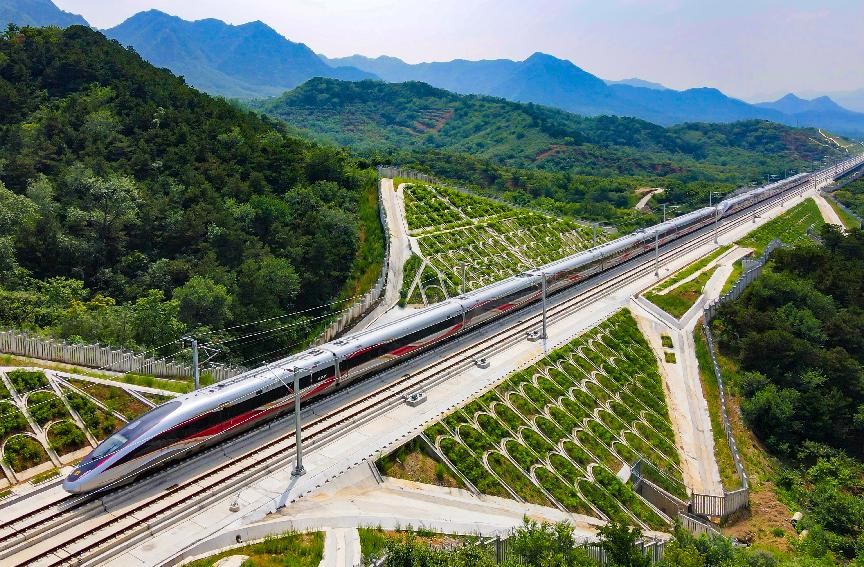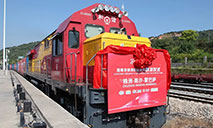China has built world’s most modern railway network
China is testing a new high-speed railway linking Ganzhou city in east China’s Jiangxi province and Shenzhen city, south China’s Guangdong province, a section of the Beijing-Hong Kong high-speed railway connecting the country’s capital city with its Hong Kong Special Administrative Region.
With a total length of 436.37 km and a designed top speed of 350 km per hour, the Ganzhou-Shenzhen high-speed railway is expected to open to traffic at the end of this year and shorten the travel time between the two cities by train from seven hours to two hours.
“After the high-speed railway is put into operation, the old revolutionary base areas in southern Jiangxi will enjoy better connection with the Guangdong-Hong Kong-Macao Greater Bay Area and embrace new opportunities for development,” Zhang Handong, chief engineer of Nanchang-Jiujiang Intercity Railway Co. Ltd., constructor of the Jiangxi section of the railway, said with pride.
The Ganzhou-Shenzhen high-speed railway is an example of the rapid development of railways in China. Since the People’s Republic of China (PRC) was founded more than seven decades ago, the country has built the most modern railway network and the most advanced high-speed railway network in the world.
When the PRC was founded in 1949, the country had only 22,000 km of railways. During the past more than 70 years, China has pushed ahead with railway construction and constantly improved the quality of its railway network.
Since 2012, China has seen railways pass through remote windy areas in the north, meander in mountains and over rivers in the southern regions, thread through snow-covered areas in the northeast and zigzag in water towns in the south, gradually turning its blueprint for building a massive high-speed railway network with eight horizontal lines connecting the east and the west and eight north-south ones into reality.
By the end of 2020, China’s railway network had grown to 146,000 km in length, and the total length of high-speed railways had reached 38,000 km, which represented an increase of almost five times compared with a decade ago and accounted for more than two-thirds of the total length of the world’s high-speed railways.
“High-speed railway has made it so convenient for me to go home and visit my brother and sister. It saves me about five or six hours on the journey home,” said Yu Ruiqin, a resident in Beijing, who is glad that she can now take high-speed trains to visit her siblings in Zhangjiakou city, north China’s Hebei province.
Since the founding of the PRC, the country has independently built a plateau railway with the highest altitude in the world, a heavy-duty railway with the greatest load-carrying capacity in the world, and the world’s fastest intelligent railway. The Fuxing high-speed trains, over which the country owns full intellectual property rights, run with a minimum departure interval of about three minutes.
Last year, railways in China witnessed over 2.2 billion passenger trips and a passenger turnover of more than 826.6 billion pkm, which were 21 times and 64 times, respectively, the figures when the PRC was founded. Besides, China’s railways transported over 4.55 billion tons of cargo, 81 times that handled in 1949 when the PRC was founded.
The construction of railways has also effectively driven the development of some regions in the country.
“China State Railway Group Co., Ltd. (China Railway) invested in our village and helped local villagers open a number of hotels and increase their income,” said Zhou Shengzhan, deputy chief Luanchuan county, Luoyang city, central China’s Henan province.
Thanks to the help of China Railway, Xinnan village in Luanchuan county has been turned into a “railway town” located near mountains and rivers. The train-themed restaurants and bars in the small “railway town” have attracted many visitors.
Since 2012, railway departments in the country have fully leveraged advantages of the railway sector to contribute to poverty alleviation by advancing construction of railway lines, connecting 109 more counties to the country’s railway network and providing 198 more counties with access to high-speed railway services.
Trying to benefit impoverished areas with transportation services, China’s railway authorities have kept the fares of 81 pairs of public welfare slow trains unchanged in 26 years. These trains handle 12 million passengers a year and carry fresh agricultural products for residents along the routes for free.
While pursuing fast development, China’s railway sector attaches great importance to energy conservation and emission reduction, trying to contribute to the country’s goal of peaking its carbon emissions before 2030 and achieving carbon neutrality before 2060.
The energy structure of the railway sector has been constantly adjusted and optimized since 2012. At present, electrified railroads account for about 75 percent of the country’s total railways. The annual consumption of fuel by railways in the country has dropped from its peak of 5.83 million tons in 1985 to 2.31 million tons, a reduction of 60 percent, which is equivalent to reducing carbon dioxide emissions by 12.56 million tons a year.
 |
Photos
Related Stories
- Track-laying work completed for major railway in China's Xinjiang
- Railway trips near 35 mln in China during holiday
- Tunnel on Nanning-Guiyang high-speed railway drilled through
- Chinese-built Lagos-Ibadan railway brings convenience, opportunities in Nigeria
- Railway Express to bolster economic development in Europe, foster stronger China-EU ties: expert
Copyright © 2021 People's Daily Online. All Rights Reserved.











